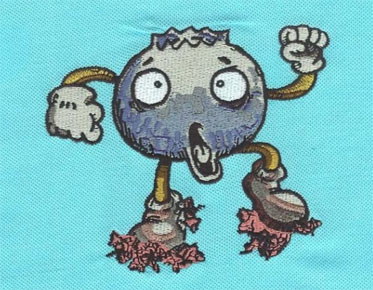A Fun Guide from Eagle Digitizing to Creating Quality Embroidery Designs
There are some fundamental issues that can have a huge impact on design quality. We need to go back to basics and create high quality embroidery designs. The following content also has some reference value for Eagle digitizing.
Machine
speed
Machine speed
has a huge impact on design quality. I cringe when I see a machine go over 850
stitches per minute. I average 750 stitches per minute, but if I'm working on a
hat it drops to 600 or 650 spi at most.
Today's
machines are sold because they run faster and you can make more in a day. Yes,
this is true, but it can also cause many problems that slow down production.
The faster your machine sews, the more tension your thread will have. This can
cause distorted satin stitches in small fonts and border-filled areas. The
faster the machine speed, the tighter the thread will be drawn and the narrower
the stitches will be. If the machine is running too fast, it can skip stitches
or force the needle into bad places and create uneven stitches, such as on
heavy leather or fabrics with wide ribs, such as twill. This really shows up on
the twill cap.
Machine
speed can also cause the thread to come out of the needle at the beginning of
sewing and leave a long thread or loop at the beginning of the first part of
sewing.
Bad tension
Your
machine will require rayon or polyester thread. You shouldn't be switching back
and forth if you can. This is something we have to do sometimes and I'm very
upset when we have to but our customers insist on a certain shade and if it matches
the rayon and not the polyester then that's what we use . I don't want to use
any rayon thread on clothes that are going to be washed in heavy duty laundry
detergent because it will fade. We haven't had any issues with our threads
bleeding.
If you stick
with polyester, you'll eliminate a lot of problems. In today's world, this is
the thread you should be using. We've been switching gradually, we're using
more and more polyester. It's stronger and of course, won't fade after
bleaching. Your polyester thread must be run at a tighter tension than rayon
thread. It's hard to keep the thread tension correct when you're switching back
and forth. It needs to be adjusted for different types of threads.
Worn or wrong needle
A worn or
wrong needle can create holes in the fabric. On knitwear, it can create runs.
You really need to be careful with this. Sometimes you can use a sharpened
needle on knits such as pique if you are using 70/10 needles and they are new.
If you work with knitwear, especially performance knitwear, it is highly
recommended that you change your needles to ballpoint needles. If you don't
switch to a ballpoint pen on these types of fabrics, you can pretty much count
on the holes in the fabric. This can have a huge impact on your design.
They recommend
that you change the needle every 2,000,000 stitches, or after every 8 hours of
continuous stitching on the same bar. It's hard to keep track of, we don't
really do that, but I always have operators who are very detail oriented and
know exactly when a needle needs to be replaced. You can hear the difference in
sound as the needle goes down into the fabric. This comes from a lot of
experience and a lot of trial and error.
Wrong
backing
Using the
correct backing or stabilizer is very important to stabilize the design of the
garment. If you use the wrong backing or a cheap one, your design could tear
right through the backing and not sew very well. It gets very twisted,
especially after being washed.
This is something you have to be very careful about. For all your woven items, you will need a tear-away backing. Never use cutouts on woven fabrics, even if they are not shown. Many times the backing will shrink which can cause the design to pull up and wrinkle. I've had several complaints about support shrinkage not appearing. I've had several students tell me they've stopped using it because it was shrinking and their designs were distorted after washing. I have some items here that have been laundered and as you can clearly see, this one hasn't shrunk a bit! You need to always use a good quality backing.
Cheap
supplies
Also don't
use cheap spools. It's huge! Not only will they slow down your production, but
they run very erratically, making it nearly impossible to maintain an even
tension flow. I highly recommend the Filtec spools. Can run right up to the
end, the tension hasn't changed, and we rarely have bad ones. Yes, they are
more expensive, but the difference in appearance and production outweighs the
difference in cost.
No topping
on knitwear
This is a difficult concept to communicate to many people. The difference in your design is night and day when you use it. Every piece of knit that comes out of my shop is finished with a top. It keeps the thread on top of the fabric instead of letting it sink into the garment, and it's super easy to remove. Yes, that's another step, but at the same time we steam it off, we also remove the hoop markers from our project. I never want to see a dress leave here with a hoop print. That's no excuse at all.
Clothing
not properly hooped
When you hoop your clothes, you want to make sure they are tight enough. If it is, the fabric inside the hoop won't move and you can hear the drumming when you hit it.
Hoop size
The size hoop you use is critical. Many embroiderers will use the same 15cm hoop for all designs. If the design was created for that 15cm hoop, that's fine, but you won't get the same effect if the design is smaller than that.
Most of the
time, all we have to do is return to the basics to produce high-quality
embroidery designs. Sometimes we forget the fundamentals and how important they
are.



